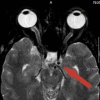Cavernous Sinus Syndrome in a Polio-Afflicted Patient With Multiple Aneurysms
- PMID: 38899274
- PMCID: PMC11185984
- DOI: 10.7759/cureus.60673
Cavernous Sinus Syndrome in a Polio-Afflicted Patient With Multiple Aneurysms
Abstract
Cavernous sinus syndrome (CSS) is a complex, multifactorial condition that presents with a myriad of signs and symptoms including ptosis, double vision, and headache. We present the case of a 65-year-old woman with a chief concern of left-eye pain, including polio syndrome and hip replacement surgery. Unlike typical CSS cases often linked to tumors, this patient's condition involved a carotid-cavernous fistula (CCF), multiple internal carotid artery aneurysms, and a pericallosal aneurysm, without any associated tumor. She presented with severe left eye pain, ptosis, double vision, vomiting, headache, and other neurological symptoms since she woke up. Her treatment at a tertiary care center included diagnostic imaging, a cerebral angiogram, and embolization procedures, and she was discharged in stable condition. This case adds significant value to the medical literature by documenting the successful management of CSS with multiple aneurysms and a CCF, highlighting the importance of personalized treatment strategies and the effectiveness of modern embolization techniques in complex neurological conditions.
Keywords: cavernous sinus aneurysms; internal carotid artery aneurysm; neuro-surgery; pericallosal aneurysm; post-polio paralysis.
Copyright © 2024, Reid et al.
Conflict of interest statement
The authors have declared that no competing interests exist.
Figures
Similar articles
-
Transvenous Coil Embolization for the Treatment of Carotid Cavernous Fistula after Pipeline Placement: A Case Report.J Stroke Cerebrovasc Dis. 2018 Apr;27(4):e65-e69. doi: 10.1016/j.jstrokecerebrovasdis.2017.10.023. Epub 2017 Nov 22. J Stroke Cerebrovasc Dis. 2018. PMID: 29174523
-
Urgent treatment of severe symptomatic direct carotid cavernous fistula caused by ruptured cavernous internal carotid artery aneurysm using high-flow bypass, proximal ligation, and direct distal clipping: Technical case report.Surg Neurol Int. 2014 Apr 15;5:49. doi: 10.4103/2152-7806.130772. eCollection 2014. Surg Neurol Int. 2014. PMID: 24818056 Free PMC article.
-
Endovascular GDC Treatment of an Idiopathic Carotid-Cavernous Fistula Caused by Aneurysmal Rupture of the Intra-Cavernous Carotid Artery. Case Report.Interv Neuroradiol. 2006 Jan 20;12(Suppl 1):174-7. doi: 10.1177/15910199060120S130. Epub 2006 Jun 15. Interv Neuroradiol. 2006. PMID: 20569626 Free PMC article.
-
Endovascular management of a ruptured cavernous carotid artery aneurysm associated with a carotid cavernous fistula with an intracranial self-expanding microstent and hydrogel-coated coil embolization: case report and review of the literature.Surg Neurol. 2007 Nov;68(5):562-7; discussion 567. doi: 10.1016/j.surneu.2006.10.074. Surg Neurol. 2007. PMID: 17961748 Review.
-
Atypical Manifestation of Direct Low-Flow Carotid-Cavernous Fistula: Case Report and Review of the Literature.World Neurosurg. 2019 May;125:456-460. doi: 10.1016/j.wneu.2019.02.027. Epub 2019 Feb 26. World Neurosurg. 2019. PMID: 30818073 Review.
References
-
- Cavernous sinus lesions. Munawar K, Nayak G, Fatterpekar GM, Sen C, Zagzag D, Zan E, Hagiwara M. Clin Imaging. 2020;68:71–89. - PubMed
-
- Carotid-cavernous fistulas. Ellis JA, Goldstein H, Connolly ES, Meyers PM. Neurosurg Focus. 2012;32:0. - PubMed
-
- Diagnosis and management of dural carotid-cavernous sinus fistulas. Miller NR. Neurosurg Focus. 2007;23:0. - PubMed
-
- Dural and carotid cavernous sinus fistulas. Diagnosis, management, and complications. Keltner JL, Satterfield D, Dublin AB, Lee BC. Ophthalmology. 1987;94:1585–1600. - PubMed
Publication types
LinkOut - more resources
Full Text Sources


